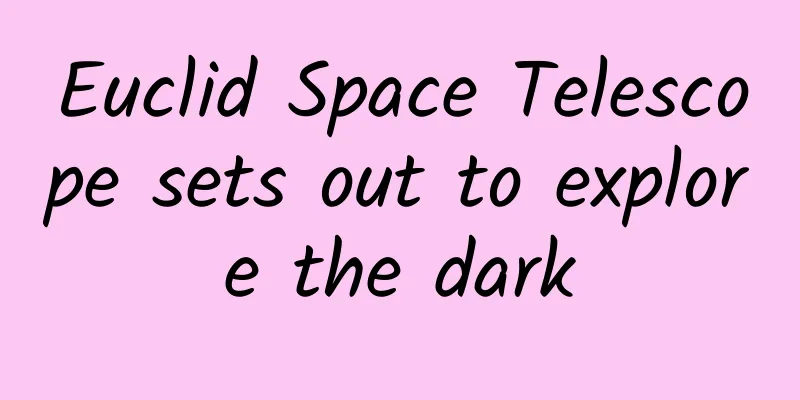Euclid Space Telescope sets out to explore the dark

|
On July 1, the European Space Agency's Euclid space telescope was launched on a Falcon 9 rocket. Named after the father of ancient Greek geometry, the telescope has begun a mission of at least six years to explore dark matter and dark energy in deep space. So why does "Euclid" go to the universe to search for "darkness"? What skills does it have to help it complete its mission? To do this, what challenges does it need to overcome? Unremittingly revealing the secrets of the "dark" universe Euclid is a mid-level mission within the European Space Agency's Cosmic Vision program, which plans to measure the shapes of more than a billion galaxies and track the precise redshifts of tens of millions of galaxies. To achieve this ambitious goal, the Euclid space telescope will cover more than 35% of the celestial sphere. In the future, the data it collects will be used to determine the expansion of the universe and the evolution of its structure over the past 10 billion years with unprecedented accuracy. Figuratively speaking, this will help astronomers draw the geometry of the universe, so it is appropriate to name the space telescope after the ancient Greek mathematician Alexandria Euclid, who founded geometry. So what is the relationship between depicting the shape of the universe and searching for "darkness"? It turns out that the European Space Agency's Planck Space Observatory mapped the cosmic microwave background between 2009 and 2013. When the first full-sky map was released in March 2013, astronomers excitedly called it a "nearly perfect universe." Subsequent studies have shown that the universe is composed of 4.9% ordinary matter, 26.8% dark matter and 68.3% dark energy. The success of the Planck Space Observatory has prompted researchers to answer the question: What are dark matter and dark energy? Despite many hypotheses, scientists have not yet been able to detect dark matter in the laboratory, nor have they been able to give a convincing explanation for the nature of dark energy. It can be said that both point to unknown physical phenomena in the universe. In particular, dark matter cannot be explained by the standard model of particle physics, and dark energy does not seem to be consistent with quantum theory, so that from time to time there is a view that "dark matter and dark energy are false propositions." Therefore, the Euclid Space Telescope has ushered in its "place". Scientists are even worried that the Euclid Space Telescope is "not enough", and NASA is expected to launch the Nancy Grace Roman Space Telescope in 2027. This detector, named after the "mother of the Hubble Space Telescope", hopes to measure the shape and redshift of galaxies throughout the history of the universe in a smaller area and search for cosmic supernova events. By then, higher angular resolution and larger wavelength coverage will ensure that it obtains precise data to help scientists further study the nature of general relativity and dark energy on a cosmic scale. It can be said that the missions of Euclid and Roman are complementary, and overlapping observations can be used to check each other's systematic errors, which is also the main source of uncertainty in high-precision observational cosmology. Working together, the two are expected to explore the mysteries of the universe more deeply. Advanced technology helps find "darkness" The Euclid Space Telescope has a launch mass of approximately 2.1 tons, is about 4.5 meters high and 3.1 meters in diameter. It consists of two major components: first, the payload module, which includes the telescope, the focal plane assembly of the instrument and some data processing electronic equipment; second, the service module, which contains power distribution, attitude control, propulsion, remote control, telemetry and data processing systems. The core of the payload module is an on-axis three-mirror cooled telescope that can provide a 1.25 degree × 0.727 degree field of view, with a thermal control system and fine guidance sensors to improve the observation effect. There is an aperture stop at the primary mirror, with an entrance pupil diameter of 1.2 meters and a focal length of 24.5 meters. In order to meet scientific research requirements, such as the internal background needs to be much lower than the ecliptic sky background, the space telescope must operate at a lower temperature. The lenses and supporting structures are made of ultra-stable silicon carbide with a cold resistance limit of about minus 33 degrees Celsius. The visible light instrument is capable of providing high-quality images and screening weakly lensed galaxies. It consists of a 12-micron pixel CCD matrix, optimized specifically for the Euclid mission, equipped with a broadband filter covering the 550-900 nanometer wavelength range, with an average image resolution of about 0.23 arc seconds. The near-infrared spectrometer and photometer are used for imaging measurements and observation of redshift information, with pixels 0.3 arc seconds wide. Among them, the photometric channel will be equipped with three broadband filters, covering three wavelength ranges of 900-1192 nanometers, 1192-1544 nanometers, and 1544-2000 nanometers. The spectral channel will be equipped with four different low-resolution near-infrared prisms, three "red" prisms, and one "blue" prism, which can perform "seamless" spectral shooting. As for the service module, it carries most of the subsystems required to operate the payload, including telemetry, power supply, thermal control, and attitude and orbit control. The module will provide X- and K-band communications. During the four-hour long-distance command and communication period each day, the K-band scientific data transmission rate is about 55 megabits per second. In order to store the large amount of data accumulated from observations, "Euclid" has a large-capacity memory of at least 2.6TB. In order to meet the requirements of high-precision imaging, "Euclid" has extremely stable pointing, and the dispersion of each visual exposure is less than 35 milliarcseconds. The Euclid Space Telescope is flying to the Sun-Earth Lagrange L2 point, about 1.5 million kilometers from the Earth, and will enter a large-amplitude orbit around the point about a month after launch. Euclid can provide the best operating conditions, a benign radiation environment, and very stable observation conditions there. For this reason, the Wilkinson Microwave Anisotropy Probe, the James Webb Space Telescope, etc. are all operating in similar orbits. In the future, Euclid will survey the deep space in a "step stare" mode: the main mirror points to a certain direction and performs imaging and spectral measurements in an area of about 0.5 square degrees around that direction. During the six-year mission cycle, its observation range will gradually cover 15,000 square degrees of the Milky Way outer space. Every day, Euclid observes adjacent areas along a constant great circle path of ecliptic longitude, and jitters are needed when necessary to improve sampling, fill in detector gaps, and ensure that the field of view is fully covered. Depending on the geometry and width of the instrument's field of view and the integration and exposure time of each field of view, it can cover an area of 15 to 20 degrees per day during the evaluation study. As needed, it can adopt modes such as deep survey and deep investigation to cover different ranges and detect celestial bodies of different magnitudes. "Tiger" shows its power to defuse crisis The Euclid Space Telescope mission was selected by ESA's Science Programme Committee in June 2012, but its implementation was not smooth sailing, with the biggest crisis occurring in late May 2021. At that time, the payload module began "cold vacuum" environmental testing indoors at the Liege Space Center in Belgium. In conventional environmental tests, the near-infrared spectrometer and photometer performed quite well. However, in the "cold vacuum" environmental test, it was found that the relevant equipment failed to start the second acquisition in time after the first acquisition was completed. This is equivalent to using a high-end digital camera. After taking a beautiful photo, we want to take another one, but the camera shutter no longer responds. The problem is that the Euclid Space Telescope is designed to transmit 850GB of data every day, and it is obviously not possible to "take a photo and restart the camera once." For a while, the problem could not be determined, perhaps signal noise in the data transmission, electromagnetic interference from other places, or even improper grounding of the cable. To find out the root cause of the problem, scientists conducted a second "cold vacuum" test, which added months to the research schedule and delayed the original launch plan. In order to resolve this crisis, ESA and relevant industry experts formed a "Tiger Team". After careful investigation, they successfully found the problem: a software error, not any physical problem. Because the cable configuration has changed very slightly compared with previous tests, it has changed the signal transmission time from the sensor to the computer interface. The software mistakenly believed that the time change was due to a "failure" in the telemetry and remote control interface of the instrument sensor, thus shutting it down. In addition, low temperatures also caused delays of a few billionths of a second. In the end, the researchers solved the problem with a software patch. By summarizing the lessons learned, the experts of the "Tiger Team" believe that when dealing with such complex software, it is important to pay attention to the interface area between hardware and software to achieve coordination and unification. The work of different companies or engineers can easily lead to misunderstandings and cause problems, which puts higher requirements on project coordination and management. The researchers have strived for perfection, creating a powerful payload module and precise orbit calculations, which will support the Euclid Space Telescope to attempt to image billions of galaxies 10 billion light-years away and across more than one-third of the sky. This is expected to help astronomers measure the history of cosmic expansion and the growth rate of cosmic structures, further provide detailed characterization of dark matter and dark energy, and test general relativity on a cosmic scale. In addition, Euclid will also conduct other cosmological research, such as analyzing the structure of the universe and deriving the mass of neutrinos, to satisfy human curiosity in exploring the universe. (Author: Liang Lei, review expert: Jiang Fan, deputy director of the Science and Technology Committee of China Aerospace Science and Technology Corporation) |
<<: Elephants and whales have so many cells, why are they less likely to get cancer?
>>: Will a zebra turn solid color if its hair is shaved?
Recommend
Saudi Arabia: The title of "Oil Kingdom" is not my whole background
In the Middle East There is such a country In the...
PPT comes true, Tesla shows 4680 battery production line, mileage increased by 16%
Recently, Tesla officially released a video showi...
How to place massive Qianchuan search ads!
Qianchuan has fully opened up the delivery of sea...
Will Apple open up its iOS operating system? It missed the opportunity 30 years ago
US financial website Marketwatch wrote on Thursda...
WeChat 8.0.10 has been updated again! 5 new features are launched. Have you upgraded?
Just yesterday, Android WeChat finally completed ...
Can the success of the Android mobile phone ecosystem be replicated in smart cars?
Even now, Microsoft still has a market share of o...
Android 5.0 Lollipop source code released
[[122293]] Google uploaded the latest Android 5.0...
Tea Science | Using the past to guide the present, how can we use tea to relieve the discomfort caused by a cold?
Recently, with the temperature fluctuating, many ...
What are the functions of the Foshan Campus Errands Mini Program? How much does it cost to create an errand running app?
Some time ago, a student came to us and said that ...
Neither running nor jumping, this action is actually the most harmful to the knees?
Unannounced Inspections Half squat for 10 seconds...
Why are some people still teenagers at the age of 70, while others suffer from cervical spondylitis at the age of 17?
In the traditional concept, cervical spondylosis ...
Ad landing page conversion is poor? 3 reasons!
The effectiveness of the landing page is related ...
This article is suitable for forwarding to the "loving family group"
This era does not only belong to young people. In...
618 Tencent News & Tencent Video e-commerce promotion advertising!
During the big promotion, how can we improve our ...
After getting a marriage certificate and having a child, what kind of game is Youpengpule playing with China News Media?
On August 4, China News Media released the latest...
![[Overseas Ukrainian Beauty Video Blessings] Short video production of foreign beauties holding signs, orders are placed all year round!](/upload/images/67cc5399e8711.webp)







![Ahua Pet Group Training July 2021 iPad Illustration Course [HD with Brush Materials]](/upload/images/67cc2735a7a14.webp)
